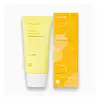What's inside
What's inside
 Key Ingredients
Key Ingredients

 Benefits
Benefits

 Concerns
Concerns

 Ingredients Side-by-side
Ingredients Side-by-side

Water
Skin ConditioningButylene Glycol
HumectantGlycerin
HumectantNiacinamide
SmoothingDipentaerythrityl Hexa C5-9 Acid Esters
Skin Conditioning1,2-Hexanediol
Skin ConditioningVinyldimethicone
CI 77891
Cosmetic ColorantSodium Polyacryloyldimethyl Taurate
Emulsion StabilisingCetearyl Olivate
Hydrogenated Polydecene
EmollientPropanediol
SolventSorbitan Olivate
EmulsifyingHydroxyethyl Acrylate/Sodium Acryloyldimethyl Taurate Copolymer
Emulsion StabilisingTrideceth-10
CleansingEthylhexylglycerin
Skin ConditioningAdenosine
Skin ConditioningTricholoma Matsutake Extract
Skin ConditioningSorbitan Isostearate
EmulsifyingTriethoxycaprylylsilane
Disodium EDTA
Hydrolyzed Cicer Seed Extract
Skin ProtectingRhododendron Chrysanthum Leaf Extract
MaskingPortulaca Oleracea Extract
Skin ConditioningHyaluronic Acid
HumectantHydrolyzed Hyaluronic Acid
HumectantSodium Hyaluronate
HumectantAscorbic Acid
AntioxidantBiotin
AntiseborrhoeicCarnitine Hcl
HumectantFolic Acid
Skin ConditioningNiacin
SmoothingPantothenic Acid
Skin ConditioningRetinyl Palmitate
Skin ConditioningRiboflavin
Cosmetic ColorantTocopherol
AntioxidantThiamine Hcl
MaskingWater, Butylene Glycol, Glycerin, Niacinamide, Dipentaerythrityl Hexa C5-9 Acid Esters, 1,2-Hexanediol, Vinyldimethicone, CI 77891, Sodium Polyacryloyldimethyl Taurate, Cetearyl Olivate, Hydrogenated Polydecene, Propanediol, Sorbitan Olivate, Hydroxyethyl Acrylate/Sodium Acryloyldimethyl Taurate Copolymer, Trideceth-10, Ethylhexylglycerin, Adenosine, Tricholoma Matsutake Extract, Sorbitan Isostearate, Triethoxycaprylylsilane, Disodium EDTA, Hydrolyzed Cicer Seed Extract, Rhododendron Chrysanthum Leaf Extract, Portulaca Oleracea Extract, Hyaluronic Acid, Hydrolyzed Hyaluronic Acid, Sodium Hyaluronate, Ascorbic Acid, Biotin, Carnitine Hcl, Folic Acid, Niacin, Pantothenic Acid, Retinyl Palmitate, Riboflavin, Tocopherol, Thiamine Hcl
Water
Skin ConditioningCentella Asiatica Extract
CleansingButylene Glycol
HumectantGlycerin
HumectantDimethicone
EmollientHydroxyethyl Acrylate/Sodium Acryloyldimethyl Taurate Copolymer
Emulsion Stabilising1,2-Hexanediol
Skin ConditioningCetyl Alcohol
EmollientCetearyl Olivate
Sorbitan Olivate
EmulsifyingCaprylhydroxamic Acid
Stearyl Alcohol
EmollientAllantoin
Skin ConditioningBetaine
HumectantPanthenol
Skin ConditioningPolysorbate 60
EmulsifyingXanthan Gum
EmulsifyingSorbitan Isostearate
EmulsifyingMyristyl Alcohol
EmollientMelaleuca Alternifolia Leaf Oil
AntioxidantEucalyptus Globulus Leaf Oil
PerfumingLauryl Alcohol
EmollientPantolactone
HumectantSodium Hyaluronate
HumectantWater, Centella Asiatica Extract, Butylene Glycol, Glycerin, Dimethicone, Hydroxyethyl Acrylate/Sodium Acryloyldimethyl Taurate Copolymer, 1,2-Hexanediol, Cetyl Alcohol, Cetearyl Olivate, Sorbitan Olivate, Caprylhydroxamic Acid, Stearyl Alcohol, Allantoin, Betaine, Panthenol, Polysorbate 60, Xanthan Gum, Sorbitan Isostearate, Myristyl Alcohol, Melaleuca Alternifolia Leaf Oil, Eucalyptus Globulus Leaf Oil, Lauryl Alcohol, Pantolactone, Sodium Hyaluronate
 Reviews
Reviews

Ingredients Explained
These ingredients are found in both products.
Ingredients higher up in an ingredient list are typically present in a larger amount.
1,2-Hexanediol is a synthetic liquid and another multi-functional powerhouse.
It is a:
- Humectant, drawing moisture into the skin
- Emollient, helping to soften skin
- Solvent, dispersing and stabilizing formulas
- Preservative booster, enhancing the antimicrobial activity of other preservatives
Butylene Glycol (or BG) is used within cosmetic products for a few different reasons:
Overall, Butylene Glycol is a safe and well-rounded ingredient that works well with other ingredients.
Though this ingredient works well with most skin types, some people with sensitive skin may experience a reaction such as allergic rashes, closed comedones, or itchiness.
Learn more about Butylene GlycolCetearyl Olivate is an emulsifier and texture enhancer. It is derived from the fatty acids of olive oil and Cetearyl alcohol, and is biodegradable.
As an emulsifier, it is used to prevent oils and waters from separating. It can also
Manufacturers use the name Olivem 1000. This ingredient has been found to preserve the natural microbiome of skin. Having a healthy microbiome helps keep our skin healthy and protects against harmful bacteria. This ingredient is grouped with Sorbitan Olivate under the name Olivem 1000.
Learn more about Cetearyl OlivateGlycerin is already naturally found in your skin. It helps moisturize and protect your skin.
A study from 2016 found glycerin to be more effective as a humectant than AHAs and hyaluronic acid.
As a humectant, it helps the skin stay hydrated by pulling moisture to your skin. The low molecular weight of glycerin allows it to pull moisture into the deeper layers of your skin.
Hydrated skin improves your skin barrier; Your skin barrier helps protect against irritants and bacteria.
Glycerin has also been found to have antimicrobial and antiviral properties. Due to these properties, glycerin is often used in wound and burn treatments.
In cosmetics, glycerin is usually derived from plants such as soybean or palm. However, it can also be sourced from animals, such as tallow or animal fat.
This ingredient is organic, colorless, odorless, and non-toxic.
Glycerin is the name for this ingredient in American English. British English uses Glycerol/Glycerine.
Learn more about GlycerinThis is a synthetic polymer. It helps improve the texture of products by adding thickness and gel-like feel.
It is also an emulsifer, meaning it prevents ingredients such as oil and water from separating. It also helps evenly disperse other ingredients.
Sodium Hyaluronate is hyaluronic acid's salt form. It is commonly derived from the sodium salt of hyaluronic acid.
Like hyaluronic acid, it is great at holding water and acts as a humectant. This makes it a great skin hydrating ingredient.
Sodium Hyaluronate is naturally occurring in our bodies and is mostly found in eye fluid and joints.
These are some other common types of Hyaluronic Acid:
Learn more about Sodium HyaluronateSorbitan Isostearate is an emulsifer and cleaning agent. It is created from isostearic acid and sorbitol.
As an emulsifier, Sorbitan Isostearate prevents oils and water from separating.
Due to its isostearic acid base, it may not be safe for Malassezia or fungal acne.
Learn more about Sorbitan IsostearateSorbitan Olivate is created from the fatty acids in olive oil and sorbitol.
This ingredient is an oil in water emulsifier. It helps stabilize a product by preventing oils and waters from separating. Sorbitan Olivate also helps hydrate the skin.
Manufacturers sell sorbitan olivate under the name OliveM 1000. OliveM 1000 a multifunctional ingredient. It is self-emulsifying. According to a manufacturer, OliveM 1000 does not disrupt natural skin biome.
Due to its olive oil base, this ingredient may not be fungal-acne safe.
Learn more about Sorbitan OlivateWater. It's the most common cosmetic ingredient of all. You'll usually see it at the top of ingredient lists, meaning that it makes up the largest part of the product.
So why is it so popular? Water most often acts as a solvent - this means that it helps dissolve other ingredients into the formulation.
You'll also recognize water as that liquid we all need to stay alive. If you see this, drink a glass of water. Stay hydrated!
Learn more about Water